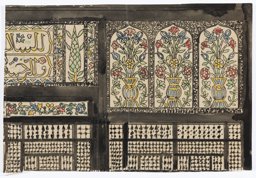Giese, F. (2016). From Style Room to Period Room: Henri Moser’s fumoir in Charlottenfels Castle. In: S. Costa, D. Poulot, & M. Volait (Eds.), Period rooms. Allestimenti storici tra arte, gusto e collezionismo: Atti del Convegno Internazionale, Bologna, 18-19 aprile 2016 (pp. 153–160). Bologna: Bolonia University Press.
Giese, F. (2019). International Fashion and Personal Taste: Neo-Islamic Style Rooms and Orientalizing Scenographies in Private Museums. In F. Giese, M. Volait, & A. Varela Braga (Eds.), À l’orientale: Collecting, Displaying and Appropriating Islamic Art and Architecture in the Nineteenth and Early Twentieth Centuries. Arts and Archaeology of the Islamic World, 14 (pp. 92-110). Leiden/Boston: Brill.
Giese, F. (2019). Orientalisierende Fumoirs in der Schweiz: Islamische Architekturzitate zwischen Nachahmung, Abguss und Assemblage. In F. Giese, L. el-Wakil, & A. Varela Braga (Eds.), Der Orient in der Schweiz: Neo-islamische Architektur und Interieurs im 19. und 20. Jahrhundert. Welten des Islams, 10 (pp. 59–84). De Gruyter.
Giese, F., & Varela Braga, A. (2019). Translocating Metropolitan Display Strategies in 19th-century Europe: Frederick Stibbert, Henri Moser and their Orientalist Style Rooms. International Journal of Islamic Architecture, 8(1), 115-140. https://doi.org/10.1386/ijia.8.1.115_1
Handwritten letter by Auguste Bruin, Paris, 17 May 1908, Bernisches Historisches Museum, BHM Ethno. Inv. 1908.670.162.
Handwritten letter by Auguste Bruin, Paris, 19 May 1908, Bernisches Historisches Museum, BHM Ethno. Inv. 1908.670.162.
Handwritten letter by Henri Moser-Charlottenfels, Charlottenfels, 3 June 1908, Bernisches Historisches Museum, BHM Ethno. Inv. 1908.670.162.
Handwritten letter by Henri Saladin, Paris, 12 May 1909, Bernisches Historisches Museum, BHM Ethno. Inv. 1908.670.162.
Handwritten letter by Henri Saladin, Paris, 13 May 1909, Bernisches Historisches Museum, BHM Ethno. Inv. 1908.670.162.
Kaufmann, K. (2019). Samarkand in der Bundeshauptstadt – ein Ausstellungssaal im neo-timuridischen Stil für die Sammlung Henri Moser im Bernischen Historischen Museum. In F. Giese, L. el-Wakil, & A. Varela Braga (Eds.), Der Orient in der Schweiz: Neo-islamische Architektur und Interieurs im 19. und 20. Jahrhundert. Welten des Islams, 10 (pp. 142–162). De Gruyter.
Keller, S. (2019). "Glänzende Wirkungen" – neo-islamische Glasmalerei in der Schweiz. In F. Giese, L. el-Wakil, & A. Varela Braga (Eds.), Der Orient in der Schweiz / L’Orient en Suisse: Neo-islamische Architektur und Interieurs im 19. und 20. Jahrhundert. Welten des Islams, 10 (pp. 201–221). De Gruyter.
Keller, S. (2020). “De véritables merveilles d’exécution”: Les vitraux du fumoir arabe d’Henri Moser. In Giese, F., Volait, M. & Varela Braga, A. (Eds.). À l’orientale: Collecting, Displaying and Appropriating Islamic Art and Architecture in the Nineteenth and Early Twentieth Centuries (pp. 28–38). Leiden/Boston: Brill.
Kläy, E. J. (1991). Orientalische Sammlung Henri Moser Charlottenfels. Bern: Bernisches Historisches Museum.
Prisse d’Avennes (son), É. (1896). Notice biographique sur Émile Prisse d’Avennes: voyageur français, archéologue, égyptologue et publiciste, né à Avesnes (Nord) le 27 janvier 1807, décédé à Paris le 10 janvier 1879. Paris: Société d’éditions scientifiques.
Saladin, H. & Migeon, G. (1907). Manuel d’art musulman (Vols 1–2). Paris: A. Picard. Retrieved June 26, 2024, from: ark:/13960/t2f76hh6w
Volait, M. (ed.) (2013). Émile Prisse d’Avennes (1807–1879). Un artiste-antiquaire en Égypte au XIXᵉ siècle. Le Caire: IFAO.
Zeller, R. (1915). Die orientalische Sammlung Henri Moser auf Charlottenfels. Jahresbericht des Historischen Museums in Bern 1914 (77–120). Bern: K. J. Wyss.

